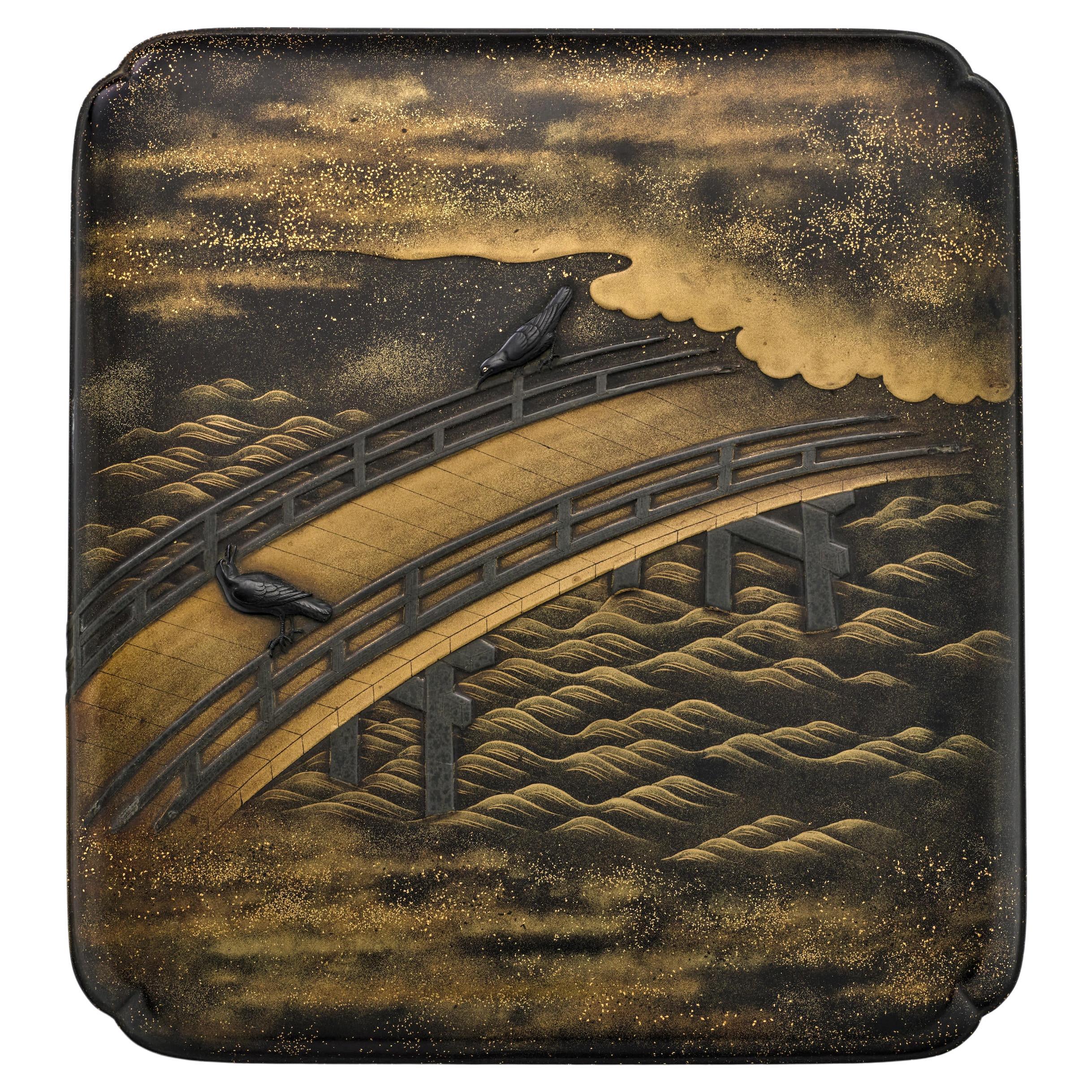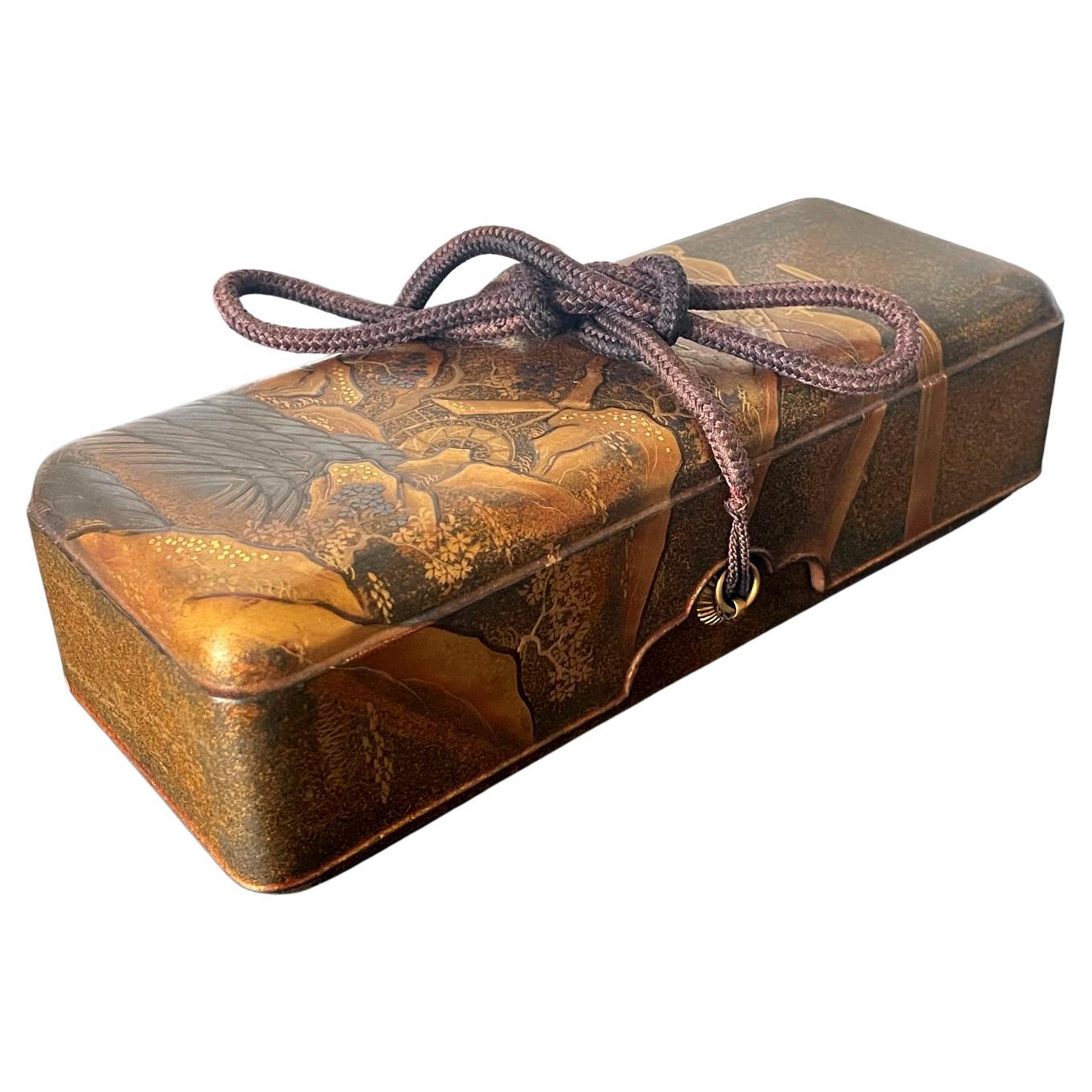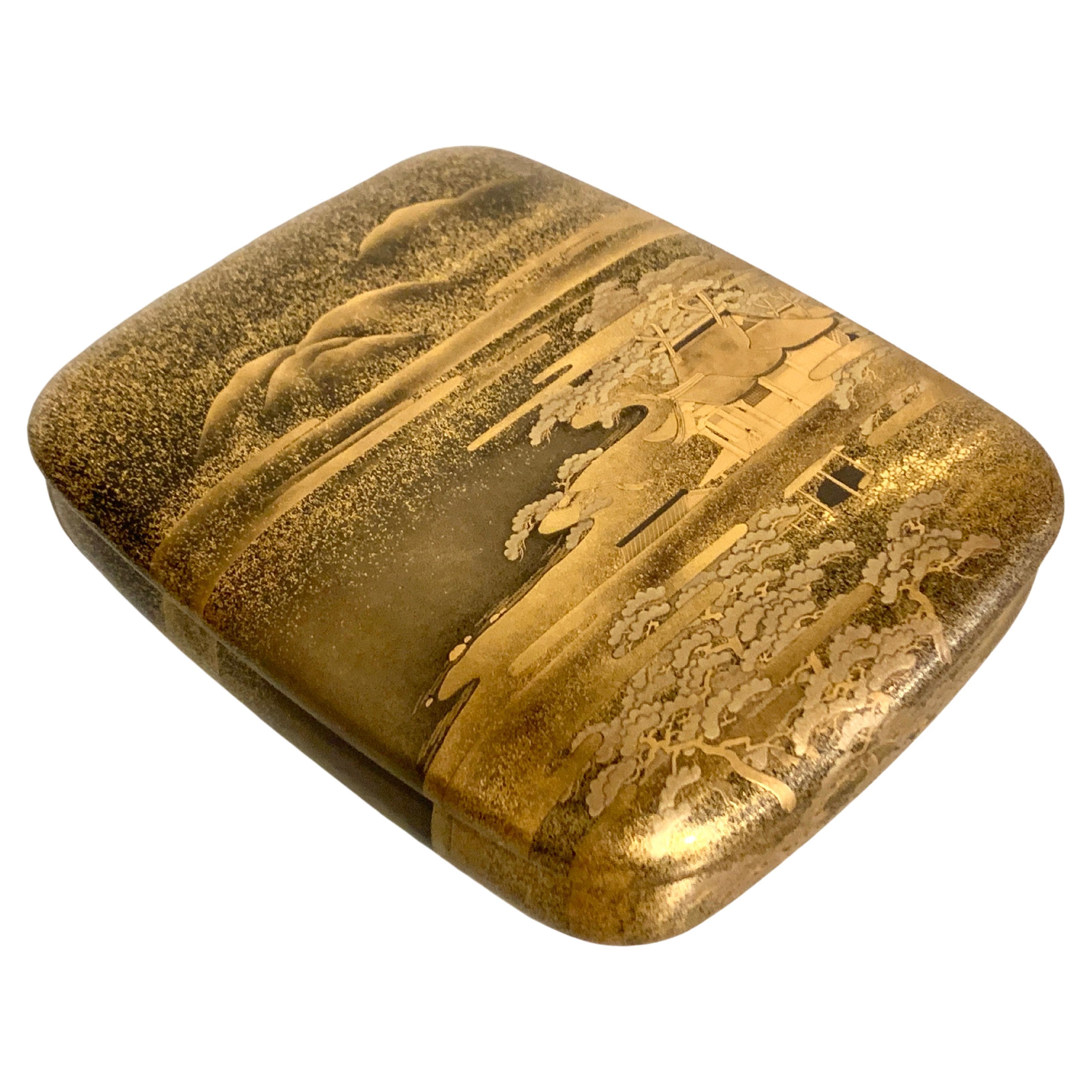Items Similar to Suzuribako decorated with a bird of prey in maki-e, Japan Edo period
Want more images or videos?
Request additional images or videos from the seller
1 of 20
Suzuribako decorated with a bird of prey in maki-e, Japan Edo period
About the Item
Exceptional suzuribako, the outside of the lid decorated with a bird of prey attached to its perch, the inside decorated with an old cherry tree in blossom behind faggots.
The interior consists of a water dropper and an ink stone on the left, and a single compartment on the right for storing writing utensils.
This suzuribako is a treat for a discerning eye, no matter where it lingers.
Japan, 18th century.
- Dimensions:Height: 2.17 in (5.5 cm)Width: 9.06 in (23 cm)Depth: 9.45 in (24 cm)
- Style:Edo (Of the Period)
- Materials and Techniques:Wood,Lacquered
- Place of Origin:
- Period:
- Date of Manufacture:1603 - 1868
- Condition:Wear consistent with age and use. Minor losses.
- Seller Location:Saverne, FR
- Reference Number:1stDibs: LU8536238400492
About the Seller
5.0
Vetted Seller
These experienced sellers undergo a comprehensive evaluation by our team of in-house experts.
1stDibs seller since 2023
6 sales on 1stDibs
Typical response time: 5 hours
- ShippingRetrieving quote...Ships From: Saverne, France
- Return PolicyA return for this item may be initiated within 3 days of delivery.
More From This SellerView All
- Small Lacquered Japanese Kazaridana Cabinet, Edo PeriodLocated in Saverne, Grand EstPrecious and rare small kazaridana lacquered on all sides with two drawers and three panels decorated with fish, landscapes and birds. The removable panel reveals a locker with a sma...Category
Antique Late 19th Century Japanese Meiji Lacquer
MaterialsWood
- Japanese Cabinet In Cinnabar Red Lacquer, Meiji Era JapanBy KinkozanLocated in Saverne, Grand EstPrecious cabinet in carved cinnabar red lacquer with two leaves and a drawer, revealing six small drawers. The doors are adorned with a porcelain plaque decorated with tits flying am...Category
Antique Late 19th Century Japanese Meiji Lacquer
MaterialsWood
- Japanese Dish In Arita Porcelain With Imari Decor Of Carps, Japan Edo PeriodLocated in Saverne, Grand EstArita porcelain dish decorated with carps. Sought-after model, rare in this condition ! Japan, late 17th - early 18th century.Category
Antique Late 17th Century Japanese Edo Ceramics
MaterialsPorcelain
- Important Japanese Arita 'Imari' Porcelain Dish Decorated with Birds, Japan EdoLocated in Saverne, Grand EstImportant Arita porcelain dish, polychrome decoration with gilt highlights, of two birds among peonies. The reverse is signed "Zoshuntei Sanpo Zu". Japan, Mid-19th Century.Category
Antique Mid-19th Century Japanese Ceramics
MaterialsPorcelain
- Japanese Arita porcelain dish with peony design, Japan Edo periodLocated in Saverne, Grand EstArita porcelain dish with decoration of a shishi among peonies. Apocryphal Chenghua mark on reverse. Japan, 18th centuryCategory
Antique 18th Century Japanese Edo Ceramics
MaterialsPorcelain
- Japanese Arita Porcelain Dish With Imari Shishi Decor, Japan Edo PeriodLocated in Saverne, Grand EstArita porcelain dish decorated with a shishi jumping in a vase. Excellent condition ! Japan, 18th century.Category
Antique 18th Century Japanese Edo Ceramics
MaterialsPorcelain
You May Also Like
- Exquisite Japanese Lacquer Maki-e Suzuribako by Koma Kyūhaku Edo PeriodLocated in Atlanta, GAOne of the finest Japanese Maki-e Suzuribakos (ink box) we have on offer, the roiro color box showcases an ambient nocturnal scene in which two shakudo inlaid crows perched on the handrails of a bridge (possible the Uji Bridge...Category
Antique Early 19th Century Japanese Japonisme Lacquer
MaterialsStone, Metal
- Japanese Lacquered Maki-e Fubako Edo PeriodLocated in Atlanta, GAA Japanese lacquered wood fubako (a box used to store document or small scroll painting), circa second half of 19th century late Edo period. The rectangular box features an unusually deep lipped lid with slightly rounded corners, a conforming lower box that is almost entirely covered by the lid which has two bronze medallion rings with tasseled...Category
Antique 19th Century Japanese Edo Lacquer
MaterialsWood, Lacquer
- Edo Maki-e Japanese BoxLocated in Brescia, ITJapanese box with lacquer lid finely decorated with Maki-e, dating from the 18th century, mid-Edo period. The box is of special size to preserve important calligraphy. All sides of ...Category
Antique Late 18th Century Japanese Edo Lacquer
MaterialsGold Leaf
- Japanese Lacquer Stationery Box, Suzuribako, Edo Period, 19th c, JapanLocated in Austin, TXA fine and elegant Japanese lacquer box for writing implements or stationery, suzuribako, with an image of a Shinto shrine, Edo Period, mid-19th century, circa 1840, Japan. The exqu...Category
Antique Mid-19th Century Japanese Edo Lacquer
MaterialsGold Leaf
- Japanese Lacquer Writing Box, Suzuribako, Edo Period, 18th Century, JapanLocated in Austin, TXAn exceptionally fine and unusual Japanese lacquer writing implements box, suzuribako, in the form of a zither, koto, Edo Period, 18th century, Japan. With a modern wood storage box,...Category
Antique 18th Century Japanese Edo Lacquer
MaterialsGold, Silver, Copper
- Japanese Lacquer Maki-E Scroll Box Fubako by Kansonsai Edo PeriodLocated in Atlanta, GAA Japanese lacquered wood fubako (a box to store document or small scroll painting) circa late 18th century of Edo period. The rectangular box features a deep lid with rounded corners and recessed mid-edge and a lower box with two bronze medallion rings and tasseled silk ties. The surface of the fubako was elaborately decorated with hiramaki-e and a low takamaki-e on a mottled Mura-nashiji background. The motifs on the lid depict branches of Japanese pine with finely rendered needles on the lower part; on the upper part, it showcases fruited persimmon branches. Two different shades of gold fundame were used to contrast the design and augmented by scattered gold kirigane to highlight some of the leaves. The design continues and cascades down to all sides of the lid as well as the walls of the box. The two bronze medallions appear original to the box and the silk ties show significant fading from the age. This Fine fubako is signed on the lower wall "Kanshosai" in Kanji with a kao mark. All the trims were finished in gold fundame and the interiors a dense nashiji in gold. Kanshosai is the mark of the distinguished lacquer artist Lizuka Toyo I who also signed his work "Toyosai". He was active in the second half of the 18th century during Edo period, employed by Hachisuka Shigeyoshi (1738-1801), daimyo of Awa on Shikoku Island. Although most survived work bearing his marks are inros, he was also known to decorated trays and other larger objects...Category
Antique Late 18th Century Japanese Edo Lacquer
MaterialsWood, Lacquer
Recently Viewed
View AllMore Ways To Browse
Lacquered Cherry
Sake Ewer
Art Deco Onlay
Takasago Couple
Lacca Giapponese
Negoro Nuri
Black And Gold Lacquer Chinese Miniature Chests
Southeast Asian Pearls
Giant Silver Tray
Murano Glass Brass Table Lamps
Formed Aluminum Chair
Italian Chairs Simple
Midcentury Accent Lamp
Antique Art Nouveau Dining Sets
Hand Painted Indian
Louis 1940s
Solid Base Dining Chairs
30 Rug





